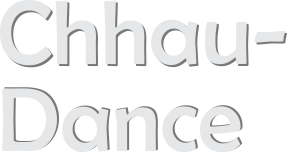
Most of the dances in India are based on mythological stories, traditions and beliefs. According to the Hindu mythology, Lord Brahma, in order to save humanity, created the fifth scripture in addition to the four vedas, which is the Natya Veda. This was created by taking certain elements from the other four Vedas such as speech from Rig Veda, Abhinaya (speech, body, dress and facial expressions) from Yajur Veda, music from Sama Veda and aesthetic experiences from the Atharva Veda. Very few Indian folk dances reflect these. One such dance is the Chhau Dance. The Chhau Dance is a dance prevalent in Eastern India. A tribal martial dance of the Indian states of Odisha, Jharkhand and West Bengal, Chhau is known for its vigour and vitality. Although there is not much difference between these dance forms at different geographic locations, some of the Chhau dances use stylized masks. The distinctive features of Chhau include the depiction of birds and animals, heroic dances with the sword, bow, or shield which demonstrates the dancer’s dexterity.
The origin of the Chhau Dance has many stories. Originated from the martial dance Phari Khanda Khela (playing with the sword and the shield), the Chhau Dance had been of interest to many rulers of Odisha during the 18thand the 19th centuries. It is believed that the word ‘Chhau’ is derived from the Sanskrit word ‘Chhaya’ meaning ‘shadow or image’. Hence, it is performed to influence the Sun God. However, according to some, ‘Chhau’ is a dialect that means six faces namely forehead, eyes, nose, cheeks, lips and chin. Ordinarily, ‘Chhau’ means ‘mask’ because the dance is performed by using mask. Most of the new theories state that Chhau is a pronunciation of the word ‘Chhauni’ which is a Military Barrack or Cantonment. The Raja of Bagmundi invented the technique of using masks and appointed the Hindu image–makers for the same. At its later and final stage, the themes of the Ramayana and Mahabharata were introduced. The dance hence, belongs to the Tandava form of Indian classical dance.
In order to maintain the sacredness of this dance, the dancers take a bath and do Puja before performing the dance. It is usually performed in an open area in the night where the fire poles called ‘mashaal’ surround the dance arena to provide light. It is mandatory for all the dancers to wear masks that are generally made up of clay and paper. Different moods of the dance are illustrated through various body movements including movements of the peaks of the masks. The movements of the mask indicate anger whereas those of the shoulder and chest indicate joy, depression and courage. Another gesture is jumping in the air which serves an attack during the enactment of a war scene.
The Chhau dance has three recognized schools or styles:
- Seraikela Chhau: A dance of the Seraikela Kharsawan district of Jharkhand, it covers the face of the dancers with a mask. The dancers emphasize on expressing their Rasa (sentiments) and Bhava (mood) through their body movements. These movements include Siro Bhedo (head gesture) and Griba Bhedo (neck gesture). However, there is no emphasis on Drishti Bhedo (movements of the eye and glances). The dance has been approved as an intangible Heritage of India by UNESCO in 2010.
- Purulia Chhau: Due to its energetic and dramatic characteristics, Purulia Chhau is perhaps, the best–known. Its vigorous aspects are illustrated in a series of Asura masks that have fierce countenance and are painted bright green and red. It is from the Purulia district of West Bengal.
- Mayurbhanj Chhau: A dance from the Mayurbhanj district of Odisha, it has highly evolved techniques of its own. It is different from the other dance forms as it is performed without masks.
Most of the rhythms of Chhau are traditional and are hence, played on Mahuri and on various types of drums. The drum, however, is an important part of the Chhau dance. The dance begins with the invocation to Lord Ganesha by beating the drums. After the invocation song, a host of musicians and drummers start beating the Dhol and the Dhamsa. Through the tunes of this music, the character of Lord Ganesha appears on the ground which is followed quickly by other characters such as the gods, demons, animals and birds.
The Chhau Dance is a very colourful dance. Its costumes include mainly pyjamas in yellow or deep green or red shade worn by the dancers playing the role of gods. Those playing the role of demons wear loose trousers of a deep black shade. Sometimes, in order to make the costumes more attractive, stripes of contrasting colours are also used. The costumes for the character of Goddess Kali are made up of unrelieved black cloth. In order to separate a distinct identity, the characters of animals and birds use suitable type of masks and costumes.
In its stages of evolution, the Chhau Dance was the earliest form of dance of the Jain and the Buddhist era. Later, it was mainly based on various episodes of the epics of Ramayana and Mahabharata. However, sometimes few episodes of Indian Puranas are also used. Out of the three styles, Mayurbhanj include solo, duet and group performances. The dance depicts two dominant Rasas, namely Vira and Rudra where in the end, the forces of evil are punished and the righteous triumphs.
The Chhau Dance involves lot of vigorous movements and energy. The dancers are expected to dance with their masks on for about 7–10 minutes. There is no discrimination against women to perform the dance. However, it is usually performed by men and boys as it is difficult to dance longer wearing a mask.


